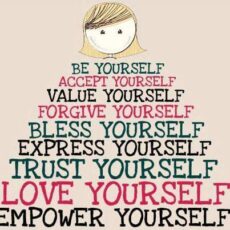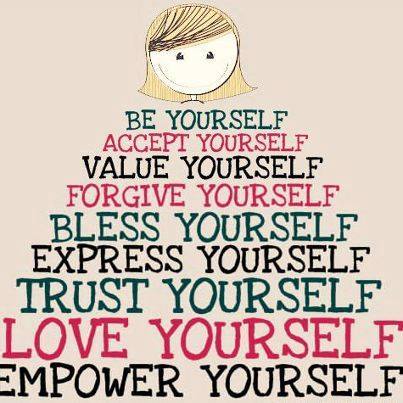
Imagine you are standing in front of a full-length mirror. Naked. You have been asked to gaze at yourself for two minutes. Now take a quick inventory of the feelings that were aroused by this suggestion. Did you feel curious or afraid? Interested or hesitant? Willing or unwilling? Or did you reject the whole idea as something you would absolutely never do? Imagining the experience gives you an indication of your level of self-acceptance; actually, doing it will tell you even more.
Self-acceptance is an action; it is something we do, not just something we feel. To say “I value myself” is an act of self-affirmation that provides a base from which self-esteem develops.When we practice self-acceptance, we don’t have to condone or even like everything about ourselves. In fact, it’s almost certain that we won’t. What it does mean is that we recognize and accept our thoughts, our actions, our emotions, our bodies, our dreams — everything about us — as our own.
“But I don’t want to be insecure (or afraid or judgmental or angry or fat or old or alcoholic or any of a dozen other things),” someone might say. “If I accept that about myself, it means I don’t want to change. Or I won’t change.”
Here’s the paradox: without acceptance of what is, it is impossible to change.
When we deny any part of ourselves, we name that part alien or outside. To say, “I don’t want to be _________, therefore I won’t accept that I am,” is self-rejection, the opposite of self-acceptance. To say, “I don’t want to be ________, but I am and I am willing to change,” is the kind of self-acceptance that gives birth to transformation.
Healing and growth can enter only when awareness and acceptance open the door. According to Nathaniel Branden, author of The Six Pillars of Self-Esteem, “Nothing does so much for an individual’s self-esteem as becoming aware of and accepting disowned parts of the self.”
Here’s another exercise: Try on any emotion that is difficult to face — insecurity, jealousy, anger, fear. Try it on as if it were a sweater or a pair of shoes. Breathe into it and focus on it; feel your feelings. Notice how, as you accept and experience it, the feeling begins to melt away.
If you are resisting — tightening your muscles, holding your breath — accept your resistance. If you deny the resistance, it will only gain in strength. But, like the feelings themselves, if you embrace the resistance, it will dissipate.
It’s not only negative feelings or thoughts we sometimes don’t accept; we refuse our positive sides, too. In fact, some of our bright side can seem more frightening than the dark. What a loss to refuse to accept our excitement or joy, our sensuality or our beauty. How sad to be frightened of our brilliance, our ambition or our dreams.
It has been said that the greatest crime we commit against ourselves is not that we deny and disown our shortcomings, but that we deny and disown our greatness.
At its very nadir, self-acceptance is what keeps us alive. It is the strength that keeps us moving; it is what gives us the courage to finally say “No!” or “Yes!” It is the hand that reaches out for help. To be self-accepting is to be for yourself, not against yourself. It is the birthright of you as an individual and every human being. For help with self acceptance please visit my store for powerful life changing MP3s https://mindset-for-success.org/shopping/hypnosis-mp3s/









